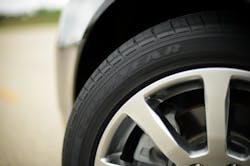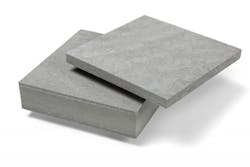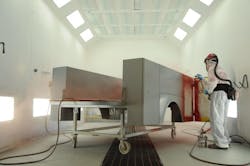It’s heartening, to say the least, to continually read about the introduction of vehicle-related innovations despite the tough economic times we’re plowing through – innovations that are reassuring, at least from where I sit, if only because they demonstrate the willingness of large and small companies alike to stay focused on the possibilities of the future versus the gloom and doom of the present.
In a way, the research and development expenses required to turn today’s ideas into tomorrow’s useful products are but one sign that no one’s ready to give up just yet and whatever awaits us in the hazy mists over yon proverbial horizon.Take for example work being conducted by the Goodyear Tire & Rubber Co. to make vehicle tires using soybean oil – a substance that could potentially increase tread life by 10% while reducing the use of petroleum-based oil by up to seven million gallons annually in Goodyear’s tire manufacturing processes.
The company added that testing conducted at Lawton, OK, tire plant showed improved mixing capabilities in the manufacturing process by using soybean oil, as rubber compounds made with soybean oil blend more easily with the silica used in building tires. This can improve plant efficiency and reduce energy consumption and greenhouse gas emissions, noted Jean-Claude Kihn, Goodyear's chief technical officer.
He added that prototype tires built in Lawton will be tested at Goodyear's Proving Grounds in San Angelo, TX, in the coming months and – if indicators remain positive – Kihn said consumers should be able to purchase passenger vehicle tires made with soybean oil as early as 2015.
Whether soybean oil will find its way into truck tires is another story, but it’s worthy to note that Goodyear successfully transferred its Fuel Max tire technology from passenger cars to truck tires in the past – technology Goodyear’s Tim Miller describes in the video clip below.
This isn’t the only tire research effort Goodyear is undertaking, by the way. It’s also working with DuPont Industrial Biosciences to develop what the two firms dub “bioIsoprene,” which is a bio-based alternative for petroleum-derived isoprene.
Goodyear noted that bioIsoprene can be used for the production of synthetic rubber—which in turn is an alternative for natural rubber—and other elastomers, thus further reducing the tire making industry's dependence on petroleum-derived products.
Another effort revolves around Goodyear's Air Maintenance Technology (AMT), to help enable tires to remain inflated at the optimum pressure without the need for any external pumps or electronics as all the AMT system components are fully contained within the tire itself.
Goodyear believes such technology offers improved fuel economy, reduced emissions, longer tire life, enhanced safety and better driving performance. Neat stuff if you ask me.
Now switch gears and think on this for a moment: a lightweight, rot-resistance yet super-strong foam designed to replace the traditional wood flooring used in the construction of many types of trailers.This material – developed by 3M and called 3M Reinforced Polyurethane Foam – goes into the making of polyurethane foam boards that, with fiberglass reinforcement, can serve in a range of applications.
Those include: marine, transportation and general construction, with a weight savings ranging from 30% to 60% versus plywood.
Available in five densities ranging from 15 pounds to 26 pounds per cubic foot and sold in 4-foot by 8-foot sheets, this stuff doesn’t chip or rot and offers better adhesion than wood due to its low moisture content, according to Nick Harris, global business leader for 3M Engineered Products and Solutions.
“Plywood is currently used in many applications where water causes it to degrade over time,” he said. “Our new reinforced polyurethane foam not only gives manufacturers a longer-lasting alternative to plywood, but one that delivers weight reduction as well.”
Now turn your attention to a new painting process from Sherwin-Williams Automotive Finishes called the Genesis G4 Basecoat system for use by fleets and OEMs.The big bang offered by this two-component 3.5 lbs. per gallon volatile organic compound (VOC) compliant urethane basecoat is simple: far faster drying times.
So fast that the Genesis G4 basecoat may be recoated after five minutes and up to seven days without sanding or scuffing with a 10-minute dry time for clearcoat application, noted Joseph Krebs, Sherwin-Williams OE/commercial marketing director.
That translates into far less downtime for fleets that want to repaint their equipment – an especially critical metric for those hanging onto trucks and trailers far longer than they ever did in the past, ensuring that they can still obtain good corrosion protection for their rolling stock while minimizing how long they must park said equipment to gain such protection.Or how about this funky new product for pickup truck users: the Elephant Stand swivel hitch.
This device helps boost worker productivity while reducing wear and tear on the back and knees.
And it all happens without any special assembly or drilling into the pickup’s frame, truck bed, or chassis, according to the company.
The all-steel device comes with a standard 2-inch towing ball and is rated for a towing capacity of 6,000 lbs.
It also sports a platform (where the "Stand" part of the product name comes into play of course) that measures 9.5 inches by 16 inches, offers 152 square inches of stepping space and is rated to hold over 600 lbs.
Check out the video below to see the "Elephant Stand" in action.
Finally, take a look at Ford Motor Co.’s use of the most unusual Repreve fabric for covering the seats of its new Focus electric car model, which went into production back in December 2011.
The amount of Repreve fabric per seat equates to using about 22 recycled polyethylene terephthalate (PET) plastic bottles in each car, the automaker said.
[Watch the video below to see how Repreve is made; a fascinating process, if you ask me!]
Just goes to show you that innovation never rests, no matter how choppy the economic outlook for the world (and the U.S.) continues to get.




